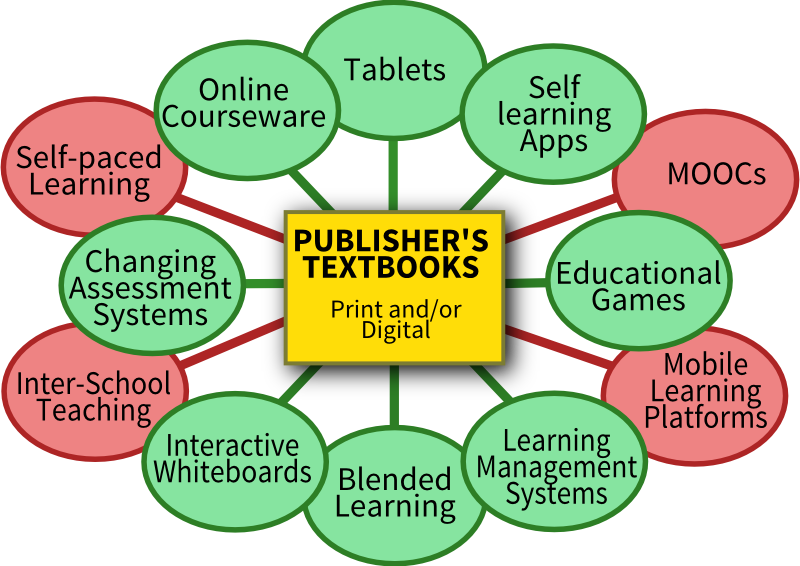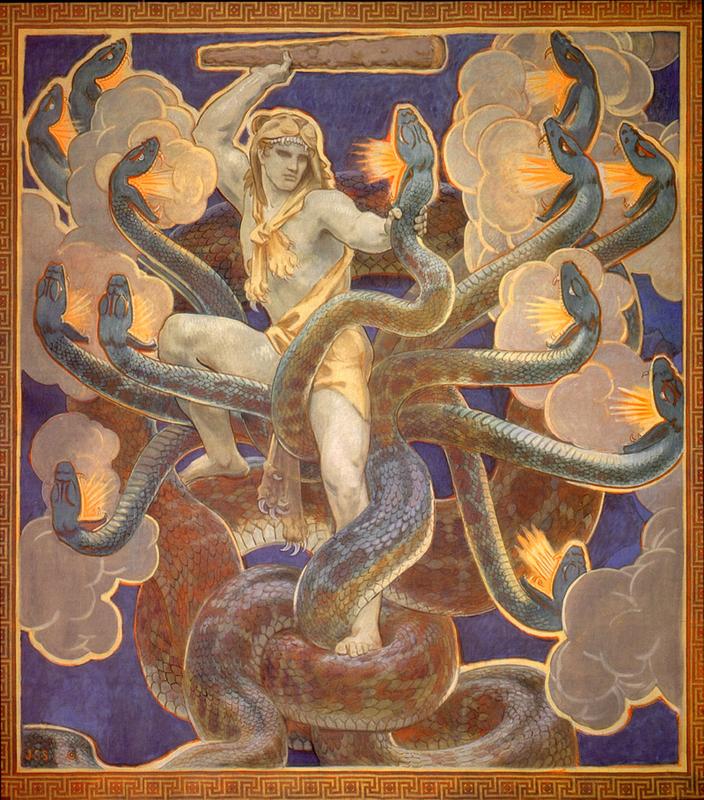Conquering the Education Technology Hydra
27 March 2014
Most K-12 Education Publishers around the world are currently selling their print books while "thinking" about digital content strategies. Many want to implement digital content strategies. There are also those who just wish it would all go away!
Most K-12 Education Publishers around the world are currently selling their print books while "thinking" about digital content strategies. Some are implementing digital content strategies. Many want to implement digital content strategies. There are also those who just wish it would all go away!
Looming over the scene is the Education Technology Hydra bringing challenges and complexities into the education publishing world that just don't exist in other publishing businesses.
The following infographic illustrates digital content and technology in education is not just about digital textbooks. Today that core curriculum focused teaching/learning tool is surrounded by the many heads of the very noisy Education Technology Hydra. Many of these heads claim to be complete education solutions in their own right.
The graphic shows technology that is commonly in use now (green) and emerging technologies that may contribute to or even change education delivery (red). (This illustration is intended to be representative rather than complete.)

This heady mix of technology can be seen as a confusion; a threat; or an opportunity for education publishers.
The Problem With Print Publishing
We have heard many education publishers say "our books are too complicated to convert to digital". This statement is largely a result of not looking up from page-flipping and X-Y print layout conditioning.
"Publishing people" around the world tend to have a pavlovian response to dense print content layout; what they regard as classical typesetting design, the page, and a page flipping e-reading systems that mimic print books. Just hint at the "purity" of print book and type design and there will be typesetting pavlovation everywhere.
An education publisher moving towards a serious digital content strategy has to "fall out of love" with their print book layouts and page flips and look into the extended future value of their content beyond the printed page; and beyond the fixed layout ebook page. The 2014 education student does not have print and paper fixations. They probably do have new pavlovian conditioned responses; like the message "vibe" on their device.
...the biggest business skill an education publisher needs in 2014 is strong change management...
This does NOT mean design, layout and engagement experience are thrown away. It means they are reconfigured, built on and redirected. Arguably the biggest business skill an education publisher needs in 2014 is strong production and marketing change management capabilities.
The Problem with Online Education Resources
There is a lot of education stuff out there on the Internet. Some of it is amazing, awesome even. There is the free stuff, the paid stuff, the game stuff, the review stuff and on and on. However there are issues, if not problems with nearly all of it:
- It doesn't fit your syllabus (if you are from any country other than the one a site addresses).
- The content locale (North America/West Europe) is completely irrelevant for nearly all other locales, plus it is nearly all in English.
- There is virtually zero accessibility considerations.
- It is difficult and time-expensive to discover, assess and work into a lesson plan (except in an arbitrary manner).
- Web page content mostly reads like print book content with colour and some limited interactivity.
- The content is pretty much just standard website gamification and engagement (although some of it is really good fun).
- Where there are big interactive things they are very specific and they over present their usefulness in a teaching and learning scenario. There are tired, years-old Java things everywhere.
- Evaluations, tests and exams are done in the country, language and locale the student lives in.
Masterfully produced publisher education content has the teacher and student entwined immediately and directly with the syllabus. This is what publishers bring to education. When that tired old, locked down print content is lifted and given a new digital life with engagement extensions for both teachers and students, education digital content comes to life like nothing from the past.
Handling The Education Technology Hydra
Trade and academic publishing are primarily concerned with producing format packages for the e-retail channels they have decided to use (or be used by). Education publishers have to look around at, and be aware of, the multitude of things happening in and around the education world.
It appears that the experience built methodological world of education is being snapped into a noisy world of perpetual change and the offerings/threats of change. But is it?
...every Education Technology Hydra head needs to be fed with content!
The Education Technology Hydra has many heads. Every ETH Head has its own story it insists you must hear and know. Each head wants to establish its own power, importance and uniqueness. They all talk at the same time. (Try having a discussion on LinkedIn about LMS or MOOCs without every other ETH Head popping in.) Every ETH Head is surrounded by a storm of consultants and experts insisting that we must change NOW. But...!
Nearly every ETH head needs to be fed with content!
The interesting characteristic about the Hydra's technology heads is that underneath nearly every "education technology"... is content. The Hydra heads do not change the syllabus or content requirement. They can change the teacher/learner engagement with the content and how, where and when it can be used.
A major objective for any education publisher should be to have their content ready to feed any or all of the Hydra's heads.
The current K-12 education digital content strategies are being driven by governments and schools that want to seem to be progressive, or actually are progressive and looking for better teaching and learning tools.
Classrooms are adopting digital devices faster than publishers are delivering content. This makes it necessary for teachers and schools to scrounge around the Internet for various resources. There is a lot of good stuff out there; but it is scattered and with very few exceptions limited in useability without excellent, permanent Internet connectivity.
Digital Content Vs. Print Content
For education publishers looking to the future; it is not what you do that matters as much as how you do it.
Traditionally produced education content is trapped in desktop production applications, is half formulated, is expensive to produce and maintain and has no future value.
To address the current print-book market AND be ready to feed any of the Education Technology Hydra heads that may rear in your direction, your content needs to be in a powerful useable and reusable management system. Ideally the same source content should be able to be produced into print books now AND also used for digital content delivery, reuse and extension.
Education Digital Content Thoughtfully
Produced...
It is reasonably easy to see an education publisher needs to maintain their content so that it can be formatted and packaged pretty much for instant use at any time in any technology framework.
This means the production and packaging HOW needs to be addressed up-front. No publisher should ever pay for their content to be packaged into a proprietary format that can only be sold through a closed channel (think Apple iPublish and Inkling). Those business models are digital content dead-end Hydra heads feeding off publishers.
Even ePub3 is a semi-standard nightmare unless you are targeting a single, all platform reading system like AZARDI. There has been some talk of ePub3 as an archive or content management format. Don't go there. Be very afraid of the limitations and mediocrity of ePub3.
Converting a print K-12 textbook, workbook or other published print learning resource to a digital eBook is not a straight-forward task, but it is a sensible first step on the path to a high-value digital content strategy. What matters is how you do the digitization.
Unlike trade and academic publishing, education content is not just about getting text and some images into some sort of reading device. At a minimum rich media enhancement is required, but there is also a minimum range of interactive teaching and learning tools that should be included.
... and Delivered
Another significant challenge with K-12 text books is how do you get them to your target market? The e-Retail options are currently Ingram with a pay per download option, iPublish with 30% to Apple or Inkling with their rather quirky book package and 30% off the top.
The other option is do it yourself. That is why we created AZARDI:Content Fulfilment so publishers can deliver their content directly to end-users on any platform or device using ePub3 with full fixed, scrolling and reflowable layout mixed in a powerful interactive package.
AZARDI:Content Fulfilment allows the secure delivery of highly interactive education content to all platforms (Windows, Linux, Mac), and smart mobile devices (Android and IOS)
The ePub3 devices and platforms are in a crazy state right now, and will probably remain there for some time.
We have a world view on this subject. That means there are a lot of different reasons for digital content education strategies to be put into place in different countries, languages, cultures and economies.
Summary
The ETH (Education Technology Hydra) is a very real "thing" that will be dominating hugh parts of education budgets, planning, thinking and more; probably to excess; certainly without noise remission. It looks scary. But education publishers have the resources, tools and "power" to keep the Hydra heads under control; to even own many of them.
It is important to remember. Technology is a moving target. It has fast moving version numbers which can change things rapidly. Where technology change was measured in years, it is now measured in weeks. Even major standards revolve and change or are rendered pointless.
Technology is designed and implemented by technologists. Technology prejudice is a very real thing. Technology expresses a closed world view and opinion. Sometimes those views click nicely. Often they click into irrelevance.
Education publishers have what is needed to make any current or "next" Education Technology Hydra head relevant on a selective basis. That means syllabus driven teaching and learning content produced to the highest standards, and made available from a framework that ensures that highest standard is maintained into the future. Any format, any package, any time.
We will be presenting more real digital content strategy options for education publishers of all sizes, all languages and all locales in future articles.
Posted by Richard Pipe
